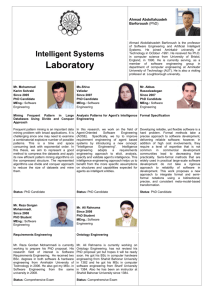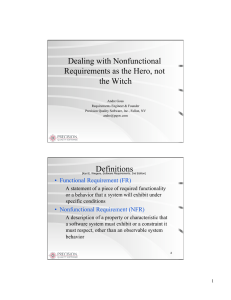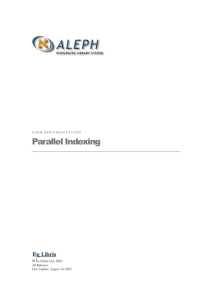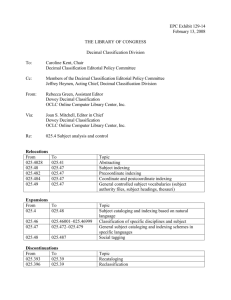word
advertisement
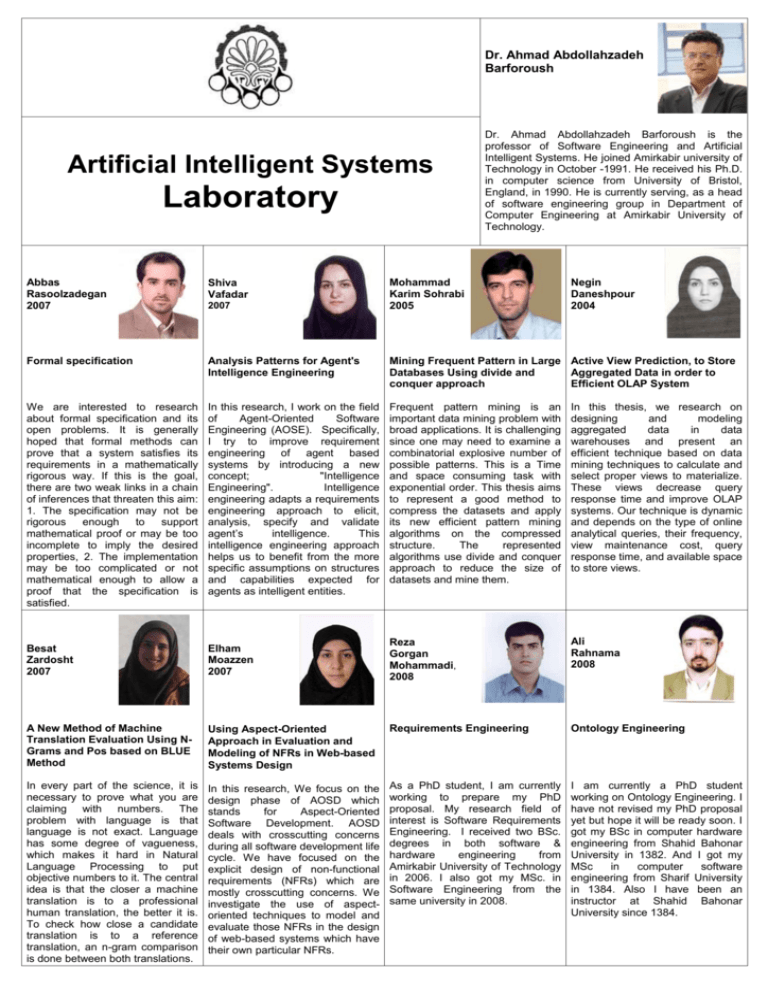
Dr. Ahmad Abdollahzadeh Barforoush Artificial Intelligent Systems Laboratory Dr. Ahmad Abdollahzadeh Barforoush is the professor of Software Engineering and Artificial Intelligent Systems. He joined Amirkabir university of Technology in October -1991. He received his Ph.D. in computer science from University of Bristol, England, in 1990. He is currently serving, as a head of software engineering group in Department of Computer Engineering at Amirkabir University of Technology. Abbas Rasoolzadegan 2007 Shiva Vafadar Formal specification Analysis Patterns for Agent's Intelligence Engineering Mining Frequent Pattern in Large Active View Prediction, to Store Databases Using divide and Aggregated Data in order to conquer approach Efficient OLAP System We are interested to research about formal specification and its open problems. It is generally hoped that formal methods can prove that a system satisfies its requirements in a mathematically rigorous way. If this is the goal, there are two weak links in a chain of inferences that threaten this aim: 1. The specification may not be rigorous enough to support mathematical proof or may be too incomplete to imply the desired properties, 2. The implementation may be too complicated or not mathematical enough to allow a proof that the specification is satisfied. In this research, I work on the field of Agent-Oriented Software Engineering (AOSE). Specifically, I try to improve requirement engineering of agent based systems by introducing a new concept; "Intelligence Engineering". Intelligence engineering adapts a requirements engineering approach to elicit, analysis, specify and validate agent’s intelligence. This intelligence engineering approach helps us to benefit from the more specific assumptions on structures and capabilities expected for agents as intelligent entities. Frequent pattern mining is an important data mining problem with broad applications. It is challenging since one may need to examine a combinatorial explosive number of possible patterns. This is a Time and space consuming task with exponential order. This thesis aims to represent a good method to compress the datasets and apply its new efficient pattern mining algorithms on the compressed structure. The represented algorithms use divide and conquer approach to reduce the size of datasets and mine them. In this thesis, we research on designing and modeling aggregated data in data warehouses and present an efficient technique based on data mining techniques to calculate and select proper views to materialize. These views decrease query response time and improve OLAP systems. Our technique is dynamic and depends on the type of online analytical queries, their frequency, view maintenance cost, query response time, and available space to store views. Besat Zardosht 2007 Elham Moazzen 2007 Reza Gorgan Mohammadi, 2008 Ali Rahnama 2008 A New Method of Machine Translation Evaluation Using NGrams and Pos based on BLUE Method Using Aspect-Oriented Approach in Evaluation and Modeling of NFRs in Web-based Systems Design Requirements Engineering Ontology Engineering In every part of the science, it is necessary to prove what you are claiming with numbers. The problem with language is that language is not exact. Language has some degree of vagueness, which makes it hard in Natural Language Processing to put objective numbers to it. The central idea is that the closer a machine translation is to a professional human translation, the better it is. To check how close a candidate translation is to a reference translation, an n-gram comparison is done between both translations. In this research, We focus on the design phase of AOSD which stands for Aspect-Oriented Software Development. AOSD deals with crosscutting concerns during all software development life cycle. We have focused on the explicit design of non-functional requirements (NFRs) which are mostly crosscutting concerns. We investigate the use of aspectoriented techniques to model and evaluate those NFRs in the design of web-based systems which have their own particular NFRs. As a PhD student, I am currently working to prepare my PhD proposal. My research field of interest is Software Requirements Engineering. I received two BSc. degrees in both software & hardware engineering from Amirkabir University of Technology in 2006. I also got my MSc. in Software Engineering from the same university in 2008. I am currently a PhD student working on Ontology Engineering. I have not revised my PhD proposal yet but hope it will be ready soon. I got my BSc in computer hardware engineering from Shahid Bahonar University in 1382. And I got my MSc in computer software engineering from Sharif University in 1384. Also I have been an instructor at Shahid Bahonar University since 1384. 2007 Mohammad Karim Sohrabi 2005 Negin Daneshpour 2004 Elham Nikooie 2008 Agent-based human computer interaction for visually disabled people The growth in Human-Computer Interaction (HCI) field has not only been in quality of interaction, it has experienced different branching in its history. Instead of designing regular interfaces, the different research branches have had different focus on the concepts of multimodality rather than unimodality, intelligent adaptive interfaces rather than command/action based ones, and finally active rather than passive interfaces. In this research we want to focus on visually impaired people and after review the existing systems for them, we will model a system for interaction of these peoples with computer (based on visual, audio or haptic methods) and finally we test our suggested system with the others. Sima Salmani 2008 Sajjad Zare 2008 Esmaeel Rezaee 2007 Using Dynamic Ontologies for Web Personalization Mapping Business Process Model to Formal Model Student Modeling in Intelligent Tutoring System. In Semantic Web environment, user access behavior models can be shared as ontology. Ontology has become an important component for Semantic Web, as it allows the description of the semantics of web content. However, majority of works have focused on generating concept hierarchy for building ontology from text documents. Recently, semantic web personalization has become an active research area. However, the current research works create ontology manually and are unable to deal with temporal access behavior. Researchers have tried to model the business process using many analytical tools, such as finite state machine, process algebra, petri net and many more. The aim of my research is defining a formalism to transform BPEL to Petri net, which enables property verification. BPEL is a language for describing the behavior of business processes based on web services. BPEL lacks formal semantics as it has been defined informally. We chose Petri net as our analytical model because of its powerful modeling capability and its nice graphic interface. Intelligent Tutoring System use methods for making educational system more adaptive. Student model is the most important feature in ITS’s. By better model, we can improve system’s adaptive ability and students’ learning process. In our approach we want to use students’ experiences as their model to help new students to improving their learning process. In this approach, we want to recommend best study fragments to new students. In this recommendation we use data mining techniques to discover the best links for recommend. This recommendation helps students to achieve necessary knowledge as soon as possible. In the other word helps them to save time in situations that choosing the best sequence of resources is time consuming. Mostafa Etemadian 2008 Indexing scientific, investigative and applied reports with agent Indexing text documents refers to selecting some words that represent the content of a document. The selected words are referred to as index words. Manual indexing of text documents is considered to be a cumbersome task in information retrieval. The people who perform indexing are usually well trained and have reasonable linguistic background. Manual indexing requires intensive human effort, since it requires people to read the whole document before selecting the candidate index words for that document. Now, finding the keywords of a text document is a challenge in indexing text documents. Also, we should pay attention to the conceptual and semantic relation between words and sentences. We want to design and implement an automatic indexing system to perform this.








